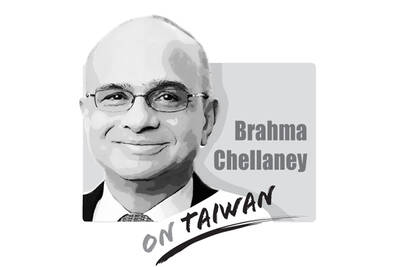Russia’s invasion of Ukraine is likely to threaten one of China’s most discreet but important strategic relationships in the past few years: its use of Ukraine as a source of technology for the expanding Chinese military.
Military analysts and diplomats have said that although the Ukraine-China link has come under increased pressure from the US, the conflict could largely scupper a trade that has helped China’s military modernize over the past two decades.
Ukrainian frustration over Beijing’s growing ties with Moscow and uncertainty over the shape of its post-war economy and government could threaten the relationship, they said.

Illustration: Yusha
“It’s always been a good hunting ground for Chinese military technicians. There is a lot there, and it has been in some cases easier to get than getting it from Russia,” Moscow-based HSE University military analyst Vasily Kashin said.
“The relationship as it was will be completely destroyed,” he said, adding that the Ukrainian government was angry at China’s diplomatic support for Russia amid other post-war uncertainties.
Beyond the high-profile acquisitions of the partially built hulk of one of the Soviet Union’s last aircraft carriers and the airframe of a carrier-capable Su-33 fighter jet, China has purchased engines for its training aircraft, destroyers and tanks as well transport aircraft, according to arms transfers tracked by the independent Stockholm International Peace Research Institute (SIPRI).
Asia-based military attaches said, less visibly, that Ukraine has long been suspected as a source of some command-and-control systems and other technology used in missiles. Ukrainian technicians have worked on a private basis inside China.
This work is expected to continue even if the official relationship sours or becomes difficult, they said.
“One traditional advantage for China in Ukraine is generally the security situation is more fluid than Russia, so it is possible to do things unofficially,” one envoy said.
The SIPRI information does not put a value on every deal it lists, but based on figures provided over the past decade, China has on an annual basis spent at least US$70 million to US$80 million.
Long-running programs include a deal worth about US$317 million to US$319 million to provide amphibious assault vehicles, and US$380 million for turbofan engines for Chinese JL-10 combat aircraft trainers, the SIPRI data show.
Another important deal was the sale of 30 gas turbines for 15 Type-052D destroyers — engines that China is producing under license, and might have also adapted and improved for more modern ships, envoys said.
To be sure, the technology China’s military technicians and engineers have acquired has enabled the growth of the country’s own indigenous design and manufacturing abilities, making it less reliant on Ukraine than it once was.
“China was very dependent on Ukrainian technology in the 1990s and early 2000s, but that has diminished more and more, particularly as China has developed its own design and manufacturing capabilities,” said Siemon Wezeman, a senior arms transfer researcher with SIPRI.
“There still may be some technology the Chinese are after, particularly aerospace and missile related… and traditionally they [Ukraine] produce quality, it is cutting edge,” Wezeman said.
Russia remains China’s most important source of military technology, but Ukraine has provided some items that Moscow can be reluctant or slow to give, reflecting its Soviet-era role as a military shipbuilding and aerospace hub.
SIPRI data show a significantly larger Russia-China trade, encompassing more advanced turbofan engines for its aircraft, radars and advanced surface-to-air, anti-ship and anti-tank missiles, as well as naval guns and transport aircraft.
However, a habitually suspicious Moscow has not always provided its latest technology to its large neighbor, the envoys said.
As an example, China’s rival South China Sea claimant Vietnam was able to obtain far more advanced Kilo diesel electric submarines from Russia over the past decade.
Ukraine might have filled an important role for China, supplying products and technology that Russia was less keen to sell, Singapore-based strategic consultant Alexander Neill said, adding that the reliance is diminishing.
“China’s own indigenous design and manufacturing capacities have improved and to a large extent; Ukraine has probably served its purpose,” he said.
Any intensifying US involvement in post-war Ukraine could also complicate the trade.
Pressure from Washington has had a significant effect. The Ukrainian government confirmed last year that it would halt the takeover of local aircraft engine maker Motor Sich by Chinese aerospace company Skyrizon due to US concerns of forced technology transfers.

China badly misread Japan. It sought to intimidate Tokyo into silence on Taiwan. Instead, it has achieved the opposite by hardening Japanese resolve. By trying to bludgeon a major power like Japan into accepting its “red lines” — above all on Taiwan — China laid bare the raw coercive logic of compellence now driving its foreign policy toward Asian states. From the Taiwan Strait and the East and South China Seas to the Himalayan frontier, Beijing has increasingly relied on economic warfare, diplomatic intimidation and military pressure to bend neighbors to its will. Confident in its growing power, China appeared to believe
Taiwan-India relations appear to have been put on the back burner this year, including on Taiwan’s side. Geopolitical pressures have compelled both countries to recalibrate their priorities, even as their core security challenges remain unchanged. However, what is striking is the visible decline in the attention India once received from Taiwan. The absence of the annual Diwali celebrations for the Indian community and the lack of a commemoration marking the 30-year anniversary of the representative offices, the India Taipei Association and the Taipei Economic and Cultural Center, speak volumes and raise serious questions about whether Taiwan still has a coherent India
Recent media reports have again warned that traditional Chinese medicine pharmacies are disappearing and might vanish altogether within the next 15 years. Yet viewed through the broader lens of social and economic change, the rise and fall — or transformation — of industries is rarely the result of a single factor, nor is it inherently negative. Taiwan itself offers a clear parallel. Once renowned globally for manufacturing, it is now best known for its high-tech industries. Along the way, some businesses successfully transformed, while others disappeared. These shifts, painful as they might be for those directly affected, have not necessarily harmed society
Legislators of the opposition parties, consisting of the Chinese Nationalist Party (KMT) and the Taiwan People’s Party (TPP), on Friday moved to initiate impeachment proceedings against President William Lai (賴清德). They accused Lai of undermining the nation’s constitutional order and democracy. For anyone who has been paying attention to the actions of the KMT and the TPP in the legislature since they gained a combined majority in February last year, pushing through constitutionally dubious legislation, defunding the Control Yuan and ensuring that the Constitutional Court is unable to operate properly, such an accusation borders the absurd. That they are basing this